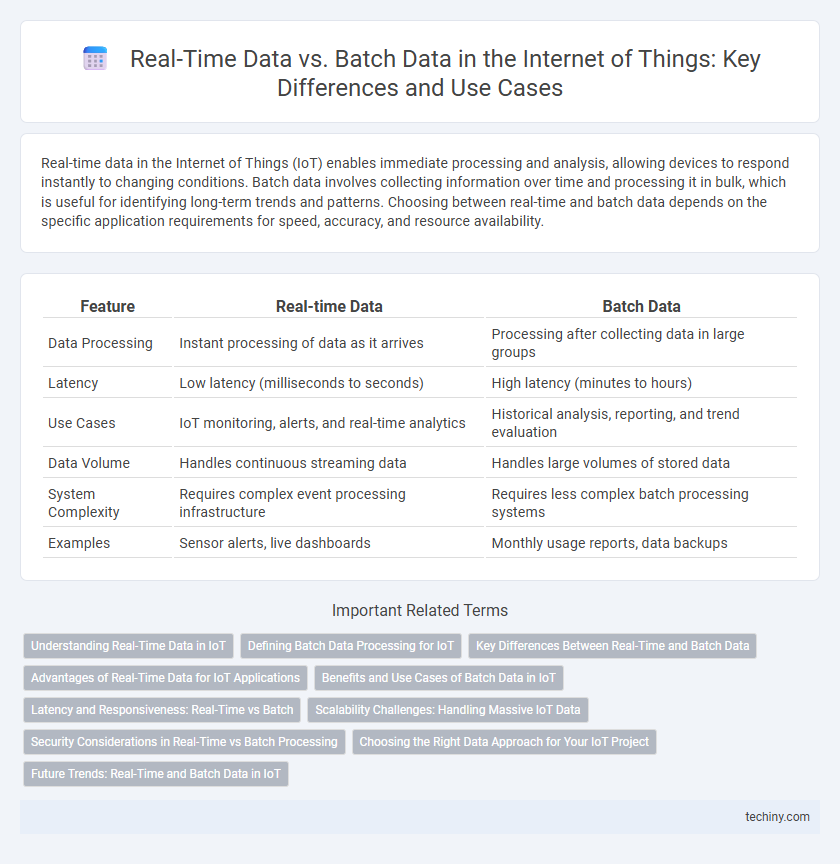Real-time data in the Internet of Things (IoT) enables immediate processing and analysis, allowing devices to respond instantly to changing conditions. Batch data involves collecting information over time and processing it in bulk, which is useful for identifying long-term trends and patterns. Choosing between real-time and batch data depends on the specific application requirements for speed, accuracy, and resource availability.
Table of Comparison
| Feature | Real-time Data | Batch Data |
|---|---|---|
| Data Processing | Instant processing of data as it arrives | Processing after collecting data in large groups |
| Latency | Low latency (milliseconds to seconds) | High latency (minutes to hours) |
| Use Cases | IoT monitoring, alerts, and real-time analytics | Historical analysis, reporting, and trend evaluation |
| Data Volume | Handles continuous streaming data | Handles large volumes of stored data |
| System Complexity | Requires complex event processing infrastructure | Requires less complex batch processing systems |
| Examples | Sensor alerts, live dashboards | Monthly usage reports, data backups |
Understanding Real-Time Data in IoT
Real-time data in IoT refers to the continuous streaming of sensor and device information that enables immediate processing and decision-making, crucial for applications requiring instant responsiveness such as autonomous vehicles and smart grids. This data is characterized by low latency and high velocity, facilitating timely actions that enhance operational efficiency and safety. Unlike batch data, which is aggregated and processed after collection, real-time data empowers dynamic analytics and adaptive control in interconnected IoT ecosystems.
Defining Batch Data Processing for IoT
Batch data processing in IoT involves collecting and storing large volumes of data generated by interconnected devices over a specific period before processing them collectively. This approach allows for comprehensive analysis, pattern recognition, and trend forecasting across extensive datasets, often used for non-time-sensitive applications like historical data analytics and reporting. Unlike real-time data processing, batch processing optimizes resource use by scheduling compute-intensive tasks during off-peak hours, enhancing overall system efficiency.
Key Differences Between Real-Time and Batch Data
Real-time data processes information instantly as it is generated, enabling immediate actions and insights crucial for IoT applications like smart traffic management and health monitoring. Batch data involves collecting and processing large volumes of information at scheduled intervals, suitable for analytics that do not require instantaneous results, such as trend analysis or historical reporting. The key differences lie in latency, processing frequency, and use cases, with real-time data supporting low-latency decision-making and batch data optimizing resource usage for large-scale data sets.
Advantages of Real-Time Data for IoT Applications
Real-time data in IoT applications enables instantaneous decision-making by continuously processing information from connected devices, ensuring prompt responses to dynamic conditions. This immediate data flow enhances operational efficiency, reduces downtime, and improves predictive maintenance through instant anomaly detection. Real-time analytics also facilitates improved user experiences by delivering timely updates and adaptive automation in smart environments.
Benefits and Use Cases of Batch Data in IoT
Batch data processing in IoT enables efficient handling of large volumes of sensor data collected over time, supporting historical analysis and trend identification for predictive maintenance and asset management. This method reduces computational load on edge devices by aggregating data before transmission, optimizing network bandwidth and storage usage in smart city infrastructure and industrial automation. Use cases include energy consumption analysis, where periodic batch processing helps utilities forecast demand, and environmental monitoring systems that compile extensive sensor readings for regulatory compliance reporting.
Latency and Responsiveness: Real-Time vs Batch
Real-time data processing in the Internet of Things (IoT) enables immediate analysis and response, minimizing latency to milliseconds, which is crucial for applications like autonomous vehicles and industrial automation. In contrast, batch data processing aggregates large volumes of IoT data over time, resulting in higher latency and less responsiveness, suitable for non-critical analytics such as trend analysis and reporting. The choice between real-time and batch data depends on the required speed of decision-making and the specific IoT use case demands.
Scalability Challenges: Handling Massive IoT Data
Real-time data processing in IoT demands scalable infrastructure to handle continuous, high-velocity data streams from millions of connected devices, ensuring low latency and immediate responsiveness. Batch data processing offers efficient management of large datasets through periodic aggregation but struggles with scalability when rapid insights and real-time decision-making are required. Balancing these approaches requires advanced distributed computing frameworks and edge computing solutions to effectively scale and manage massive IoT data volumes.
Security Considerations in Real-Time vs Batch Processing
Real-time data processing in IoT environments requires stringent security measures to prevent immediate threats such as data breaches and unauthorized access, as data is continuously generated and transmitted. Batch data processing allows for comprehensive security checks and encryption before processing, but delays in detection can increase vulnerability windows. Implementing robust authentication protocols and end-to-end encryption is critical to safeguard both real-time streams and large batch datasets in IoT systems.
Choosing the Right Data Approach for Your IoT Project
Real-time data streams provide immediate insights essential for IoT applications requiring instant decision-making, such as autonomous vehicles and smart grids. Batch data processing is suited for analyzing vast amounts of sensor data over time, enabling trend analysis and predictive maintenance in industrial IoT environments. Selecting the right data approach depends on the project's latency requirements, data volume, and the criticality of timely responses for device management and analytics.
Future Trends: Real-Time and Batch Data in IoT
Future trends in IoT emphasize the integration of real-time data processing with batch data analytics to enhance decision-making and operational efficiency. Real-time data streams enable instant insights and immediate responses, crucial for applications like autonomous vehicles and smart healthcare, while batch data supports historical analysis and predictive modeling. Advances in edge computing and AI-driven analytics are expected to further optimize the balance between real-time and batch data usage in complex IoT ecosystems.
Real-time data vs Batch data Infographic

 techiny.com
techiny.com